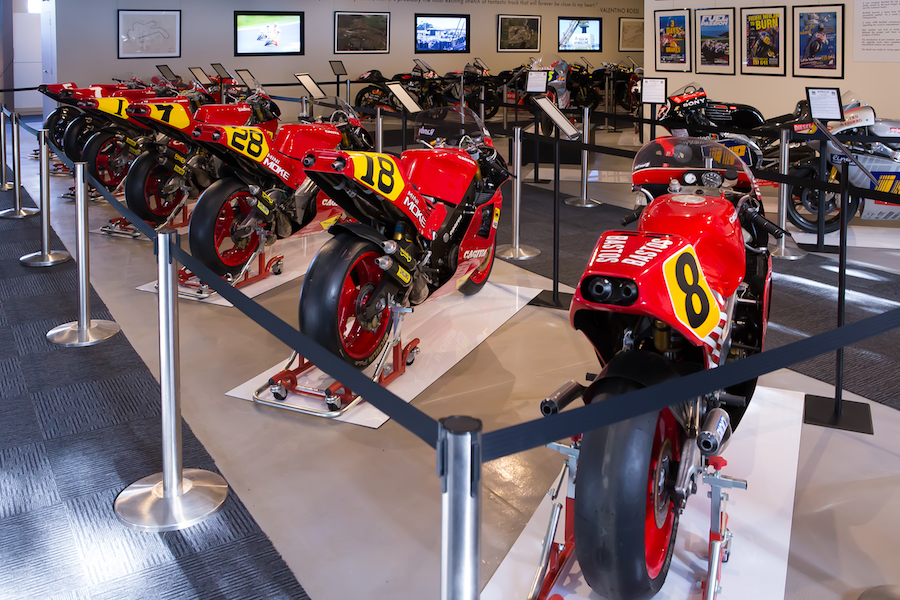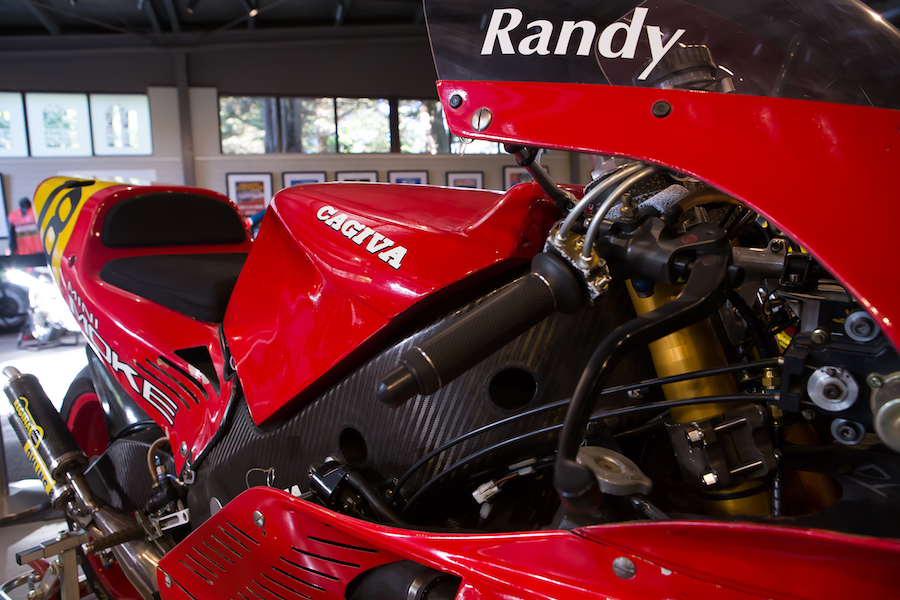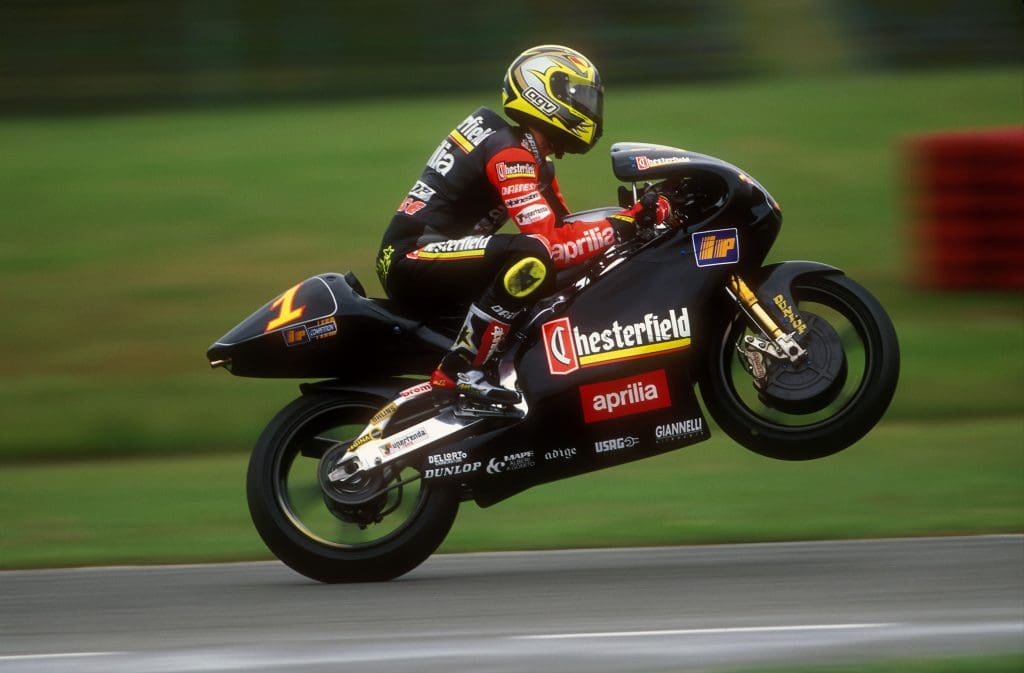Visitors to Phillip Island’s round of the Superbike World Championship will be able to view the birth of a new focus on the History of Motorsport at the circuit’s Visitor Centre. A comprehensive collection of 24 GP-winning motorcycles from Aprilia and Cagiva showcases two decades of two-stroke racing in three classes.
The acquisition by the Fox family, owners of the circuit, is the start of what could become one of the world’s most intriguing museum collections. The History of Motorsport Display at the Visitor Centre already houses a cross-section of two and four-wheeled racing on the Island, dating back to just after World War I when cars and motorcycles shared the billing at Australia’s major racing events. Now, with the signing of major international contracts that secure the future of the circuit as a mecca for international motorcycle racing, the owners have stepped up.

“We are in the very fortunate position of having people donating items from their family archives to us because they know we are on a mission to preserve Australia’s motor racing history,” says Fergus Cameron, PI’s managing director.
Other exhibits are on permanent loan from owners, including landmark racing cars from Australia’s long touring car history. Like most museums, the amount in storage is three to four times what can be displayed at once, meaning a range of exhibitions can be mounted that concentrate on various eras of both two and four-wheel racing.

The recent acquisition from Italy, however, takes the museum into new territory and Cameron has confirmed the building will have to be extended to accommodate future purchases.
Uncovered in Italy by Andrew Fox and bought from two private collectors, the new acquisitions include 15 Aprilias and nine Cagivas. They span the two-stroke GP era from 1987 to 2003 and were ridden by legends like Valentino Rossi, Max Biaggi, Loris Capirossi, Eddie Lawson and John Kocinski.

“This collection represents a sensational era of grands prix and showcases the bikes that launched some of the biggest names in motorcycle racing,” says Andrew Fox. “The bikes are all in perfect condition and I believe we have the finest collection of Cagivas anywhere in the world.”
While some motorsport fans may question the wisdom of spending a huge amount of money on just two manufacturers, the motorcycles are a perfect time capsule of technological development in that two-stroke era. If the PI team can assemble a similar collection of World Superbike racers, the museum will be well on the way to ‘bucket list’ status.

How good is the Cagiva exhibit?
The earliest Cagiva in the collection is a fascinating example of two-stroke GP racing. It’s a 1987 V587 that was ridden by Raymond Roche and which helped take the company to fourth in that year’s constructor’s championship.
It has the rawness of a prototype under development and bears a close physical resemblance to the experimental Ducati 851 four-stroke Superbike Marco Lucchinelli took to victory in that year’s Daytona Battle of the Twins. At the time Cagiva owned Ducati.
Compare that to the sleek, 1990 carbon-framed racer, parked down the line in the museum.
That Cagiva, a V590, came sixth in the British Grand Prix with Randy Mamola on board. Cagiva was gathering momentum and, with encouragement from its mainstream Japanese rivals, especially Yamaha, was challenging for podium finishes.
Further along the row is the 1993 Cagiva V593, which has a huge Australian connection. American Doug Chandler finished third at that year’s Australian GP at Eastern Creek, while Aussie teammate Mat Mladin finished ninth.

What about the Aprilias?
Looking at the line-up of Aprilias reveals some true gems of two-stroke racing, including the world title-winning machines of Rossi in 1997 (125cc), Biaggi in 1995 (250cc), Capirossi in 1998 (250cc) and Marco Melandri (250cc) in 2002.
The three RSV500s include the Aprilia Jeremy McWilliams rode to pole position in the Australian GP at Phillip Island in 2000. The Alessandro Gramigni bike of 1992 was the machine Aprilia won its first world title on in the 125cc class, while Rossi’s 1997 Aprilia RSV125 is just as significant. It took him to 11 victories, 13 podiums and a world title – and launched his career on the world stage.
Looking at the 250cc Aprilias on show we see a significant branch of the family tree.
Biaggi scored three consecutive 250cc world titles for Aprilia from 1994 to 1996, with the bike from his 1995 campaign (eight wins and four other podiums) a highlight of the Phillip Island display. Biaggi’s dominance opened the way for Capirossi, Melandri and Manuel Poggiali, whose world championship-winning bikes are also now on show at Phillip Island.

Cagiva – a short history
Brothers Claudio and Gianfranco Castiglioni were just well-intentioned motorcycle racing enthusiasts when they founded Cagiva in 1978. Less than 10 years later Cagiva (an amalgam of their father’s surname, first name and home town of Varese) was competing in tarmac and off-road world championships and was considered the world’s fastest-growing motorcycle manufacturer.
What the brothers lacked in experience they made up for with business acumen, an eye for what buyers wanted, and the ability to surround themselves with the best designers, technicians and competitors.
In 1980 they set their sights on the exploding motocross scene, winning two 125cc world championships. Cagiva also won the Paris-Dakar classic twice with Ducati-powered racers.
Cagiva’s tilt at 500cc grand prix racing was never as successful. Over 15 years from 1980 the marque only won three GPs, but it did bring the class some of the most beautiful racers ever seen.
It wasn’t until 1987 that the project got traction when ex-Belgian football director Francis Batta took over running the team. In came serious money from Bastos tobacco and riders Didier de Radiguès and Raymond Roche. The result was fourth in the constructors’ title and 12th (de Radiguès) and 13th (Roche) in the championship with a twin-crankshaft, 56o V4 in a beam-section perimeter frame similar to Yamaha’s Deltabox design.
For 1988, Cagiva brought in a new rider, Randy Mamola, and sponsor, Pirelli. Mamola gave Cagiva its first rostrum with a third in the rain at Spa. He hung in there for another two seasons but by 1991 the Castiglioni brothers were at a crossroads.
Enter Eddie Lawson, looking for a final GP challenge.

The four-time world champion brought a new momentum. His sixth in the 1991 championship with youngster Alex Barros 13th (they came third and fourth respectively in the dry at Misano) laid a strong foundation for 1992.
A ‘big-bang’ engine helped Lawson to Cagiva’s first pole position (Assen). He followed this up with Cagiva’s first win (Hungary). Finally the Castiglioni brothers had beaten the Japanese giants.
Team manager Giacomo Agostini survived a season of struggles after Lawson retired, but pulled a master stroke during 1993 when he signed firebrand Jon Kocinski. The former 250cc champion finished fourth in his first two races then won the Laguna Seca round.
Next season Kocinski won the first round, came second in the second and ended up with another five podiums to finish third overall.
To get to this stage Cagiva had pushed the boundaries of development over three seasons, introducing the first electronic gearbox quickshifter, rudimentary traction control and electronic fuel injection.
However, Cagiva was now burnt out by the GP effort and distracted by its resuscitation of the MV Agusta brand. It retired from GP racing.

Aprilia – a short history
Aprilia first got involved in motorcycle racing with easy-to-manufacture motocross, enduro and trials models in the 1970s.
Lateral thinking has long been its strength, first shown when it took the step up to tarmac racing. It used Rotax’s proven liquid-cooled, twin-cylinder, disc-valve engine to power its 250cc entry into the 1985 GP championship. Loris Reggiani finished the season sixth overall (Freddie Spencer did the 250/500cc double that year) and Aprilia was third in the manufacturer’s championship.
By the 1990s Aprilia was slugging it out with Honda for the title of GP’s leading manufacturer in the smaller classes. Meanwhile its privateer and distributor machines were winning national championships around the world.
In 1994 Aprilia’s resident genius engineer Jan Witteveen took the step up to the 500cc class with the 250cc V-twin enlarged to 410cc (eventually 460cc).
The logic was that current top 250cc racers were qualifying faster than many of the four-cylinders on the 500cc grid. He gambled on the fact that the twins were allowed a minimum weight of 105kg compared to the fours’ 130kg.
This gave the smaller bikes a potential handling advantage. Honda also saw the logic and introduced its NSR500V as a privateer option.
Aprilia won the 125cc and 250cc classes but was badly outclassed in the 500cc title chase. The next season Reggiani finished 10th, a feat Doriano Romboni repeated in 1997.
Aprilia regrouped in 1998 (it still achieved the 125cc/250cc title double) and returned with determination in 1999. Tetsuya Harada finished 10th and was joined by Jeremy McWilliams for season 2000.
Despite McWilliams finishing third in the Italian and British GPs, his title challenge was blunted by six race retirements. He finished 14th and Harada 16th with Aprilia fourth in the constructors’ title behind the ‘big three’ Japanese factories.
The next year the 500cc class became four-stroke MotoGP. Aprilia would eventually join in with the ill-fated three-cylinder Cube.












